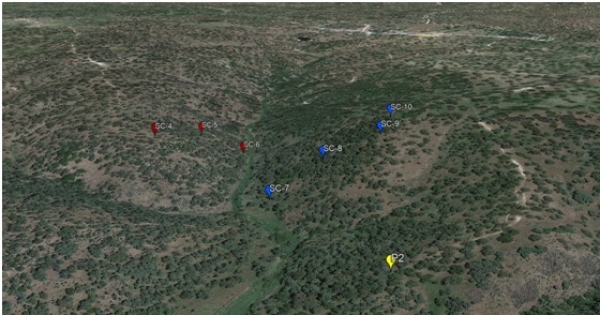Soil is an essential reservoir of the water cycle, not so much because of the volume it represents, but rather due to its continuous renewal and because of humanity's ability to take advantage of it. Although the evolution of the climate in the medium and long term may modify current conditions, thevariability of precipitation can cause notable changes in the natural systems of arid and semi-arid areas, accelerating their degradation, especially due to erosion, and, with it, the loss of soil. Thus, the challenge is not just to conserve the soil, but rather to accelerate its formation.
Soil formation processes depend on hydrological ones, so it is important to study the evolution of its humidity as an indicator. Researcher Vanesa García Gamero, together with professors at the University of Córdoba's Agronomic and Mountain Engineering School (ETSIAM) Adolfo Peña, Ana Laguna, Juan Vicente Giráldez and Tom Vanwalleghem, researchers associated with the AGR-127 Hydrology and Agricultural Hydraulics group at said institution, have measured soil moisture for 3 years in a dehesa located on granite materials in Cordoba's Sierra Morena mountain range to explore asymmetries in the basin and the factors that control this variable.
Between 2016 and 2019 the team analysed the evolution of soil moisture through a network of 32 sensors on two opposite slopes, one facing north and the other facing south. They examined the vegetation dynamics by estimating biomass and the Normalized Difference Vegetation Index (NDVI) obtained from the Sentinel-2 satellite of Europe's Copernicus mission, which indicates the greenness of the plant, together with the dynamics of the water table, which was only detected on the north-facing slope.
While the soil moisture dynamics are similar on both slopes, the results reveal a difference in terms of vegetation. The estimated biomass on the north-facing slope is 29% higher than on the south-facing slope. The NDVI pattern reflects opposite trends on the two slopes, with the minimum values being reached at different times of year: on the south-facing slope it occurs in the summer, while on the north-facing slope it occurs at the end of winter.
The orientation of the slope has a hydrological effect through the vegetation and the subsurface structure of the "critical zone" (the layer that extends from the canopy of the trees to the bottom of the groundwater), thus termed for its importance to the natural systems on which humanity depends. The soil on the south-facing slope is shallow, while on the north-facing slope a 9.50 m layer of fragmented and weathered material lies under the soil profile, which augments the water storage capacity on the north-facing slope, not only as soil moisture but in the form of "rock moisture", water stored in the underlying zone up to the saturated area, highly weathered, and as underground water, only detected on this slope. The vegetation on the north-facing slope could be sustained not only by the soil moisture, but also by that of the rock and the saturated zone, while the only source of water that the vegetation on the south-facing slope has is the soil moisture.
These conclusions are of interest, especially for semi-arid climates such as the Mediterranean's, as rock humidity could provide an additional source of water to sustain vegetation during periods of drought.
References
García-Gamero, V., Peña, A., Laguna, A.M., Giráldez, J.V., Vanwalleghem, T.,2021. Factors controlling the asymmetry of soil moisture and vegetation dynamics in a hilly Mediterranean catchment. Journal of Hydrology. https://doi.org/10.1016/j.jhydrol.2021.126207
This work is supported by the "Establishing a Critical Zone Observatory for Hydropedology and Sustainable Agriculture in the Mediterranean" (AGL2015-65036-C3-2-R) project, financed by the State Program for Research, Development and Innovation, oriented to the challenges of society; 81/150 for the four-year period 2016-2020 (MINECO/FEDER, EU). Vanesa García-Gamero received an FPU grant (FPU15/05279) from the Ministry of Education, Culture and Sports.
Vanesa García Gamero, Juan Vicente Giráldez and Tom Vanwalleghem are members of the University of Cordoba's Department of Agronomy, recently granted a María de Maeztu Recognition of Excellence.
Adolfo Peña belongs to the Department of Rural Engineering, Civil Construction and Engineering Projects at the University of Cordoba.
Ana Laguna belongs to the Department of Applied Physics, Radiology and Physical Medicine at the University of Cordoba.
Juan Vicente Giráldez is also an associate researcher at the CSIC's Institute of Sustainable Agriculture.


